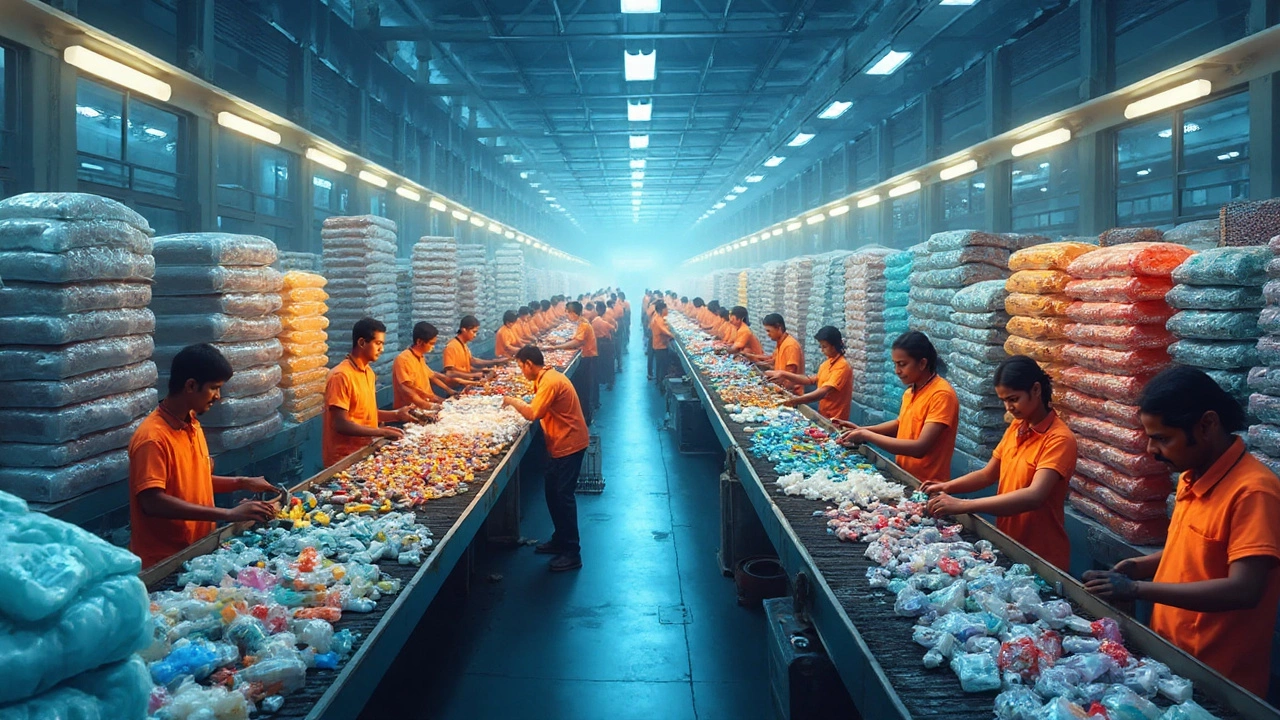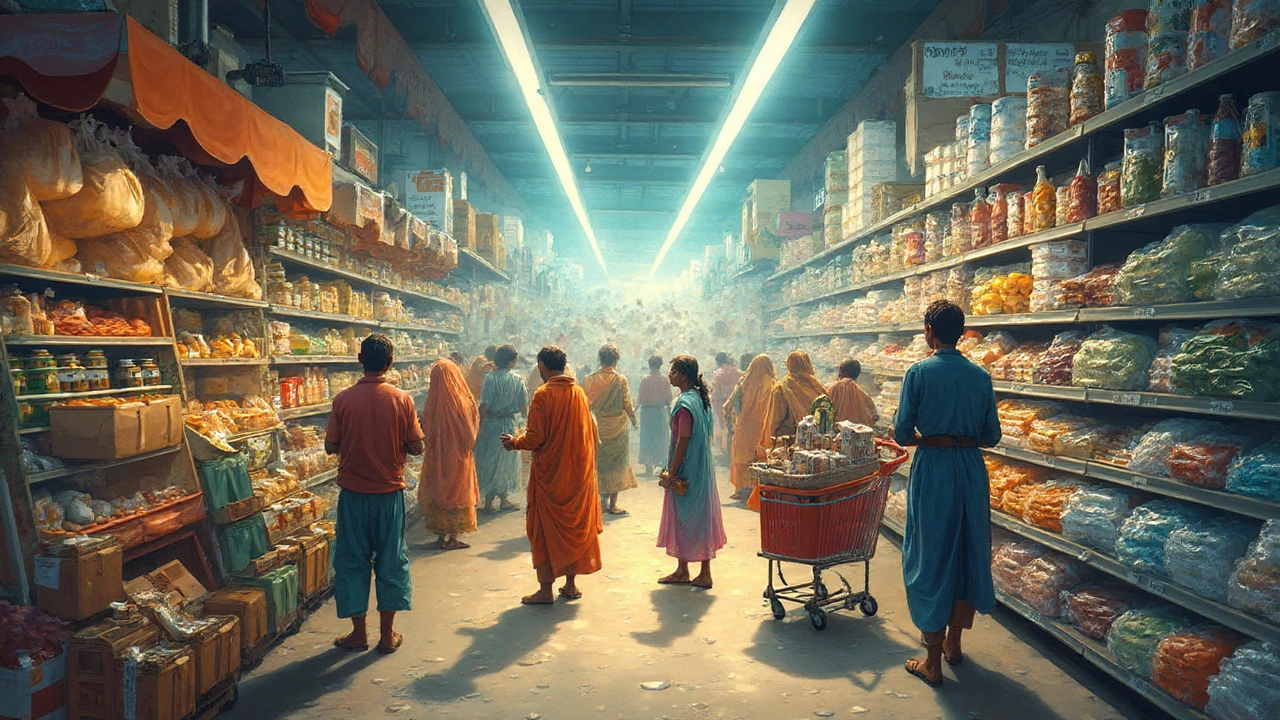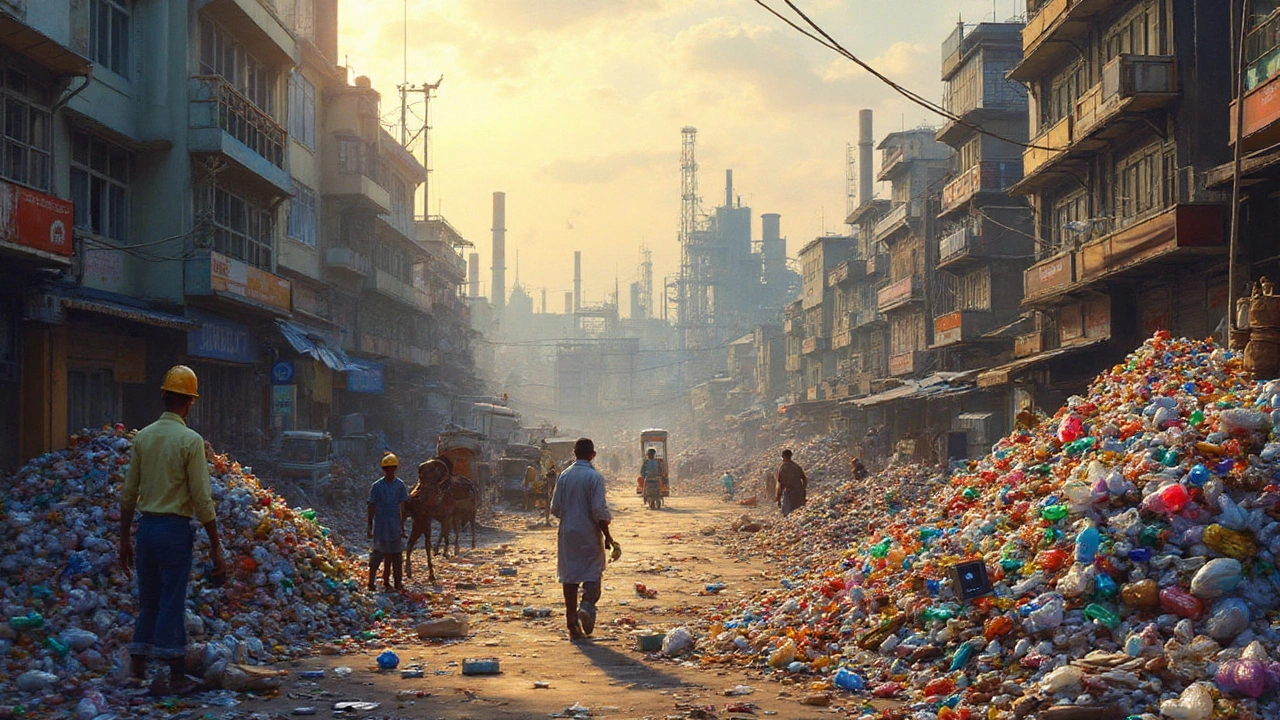Look around right now—how many things do you see made of plastic? Your phone case, a pen, maybe even the chair you’re sitting on. It's everywhere. But there's one industry gulping down plastic at an eye-watering rate, turning it into products we use every single day, usually without thinking twice. Want to know which one? Don’t blink. The answer will probably surprise you, especially when you see just how big the numbers get—think millions of tons, not just bags in the cupboard.
The Giants of Plastic: Who’s Really Using the Most?
If you had to bet on the biggest plastic guzzler, you might guess electronics or maybe even toys. No chance. The clear winner is packaging—hands down, not even close. According to the 2023 PlasticsEurope Market Data, packaging eats up around 40% of all plastic produced each year. That’s more than the next three biggest plastic-hungry sectors combined: construction, automotive, and electronics.
The mountain of single-use packaging—those clingy wraps, bottles, disposable trays, fruit containers, and shipping films—doesn’t just come from supermarkets. Think about every time you order a takeaway, the first thing you see is plastic. The box your new phone came in? Layers of plastic padding. Even medicine blister packs add to the mountain. Here’s how the breakdown stacked up globally in 2023:
| Industry | Percentage of Global Plastic Use |
|---|---|
| Packaging | 40% |
| Construction | 19% |
| Automotive | 9% |
| Electronics | 7% |
| Consumer Goods | 12% |
| Others | 13% |
What’s wild is that packaging’s lead keeps getting bigger, thanks to online shopping, food delivery, and fast-moving consumer goods. In fact, last year, e-commerce added another 4 million tons of packaging plastic worldwide, according to the Ellen MacArthur Foundation.
Worried that builders might overtake packaging? Not a chance. Most construction plastics last decades (think PVC pipes or insulation), while packaging gets ripped open and binned within minutes of reaching your home. The difference is staggering—packaging’s speed is what makes it both essential and problematic.
Why Does Packaging Use So Much Plastic?
It’s not just about bubble wrap for your fragile lamp. Packaging gobbles plastic because it’s cheap, light, waterproof, and almost magically moldable. Food producers, especially, love it since plastic keeps things fresh, safe, and attractive. And let’s face it: paper containers aren’t great for soup. The bakery down the street isn’t wrapping croissants in linen. Plastic is the go-to.
But it’s not all about convenience. Modern supply chains rely on plastics for traceability, safety, and hygiene. Whether it’s pre-packed meat, medical gear, or electronics shipped from halfway around the globe, plastic does the job. Quick side note—reusable shopping bags sound great. But UK government research in 2024 showed that each well-used ‘bag for life’ still requires 3-5 times the plastic of a throwaway one. Reuse does make up for it, but only if you actually do it! (How many times have you forgotten yours?)
Marketing plays a sneaky role, too. Brands use plastics for stand-out shapes and colors on shelves. Ever see those little ketchup sachets or tiny shampoo bottles in hotels? They’re marketing, not just storage. Packaging is often custom and single-use because companies want to stand out, not blend in. This has driven a dramatic rise in uniquely shaped and colored plastic packaging wastes, making recycling a headache.
And let’s not ignore the pandemic effect. Demand for hygienic packaging soared. Single-serve food, delivered meal kits, PPE wraps—they all require virgin plastic. Shops were quick to switch back from unpackaged to pre-packed items for hygiene reasons. One study by the Earth Institute in 2022 showed that plastic packaging waste in food delivery alone tripled in larger cities across Europe and Asia during just the first year of COVID-19.

Heavyweights: Other Industries Swimming in Plastic
If packaging is the massive whale in the room, what about the others? Construction uses a big chunk of plastic, but in a different way. Pipes, window frames, and insulation must last a lifetime. These are not turn-and-burn plastics. The automotive sector needs plastic for dashboards, bumpers, and internal panels—much lighter than metal, much cheaper, and often safer in a crash. Meanwhile, electronics could not exist without precise, tough plastics protecting sensitive circuits, batteries, and wires.
Let’s pause on electronics for a second. A typical smartphone contains over 40 different types of plastic—insulation, connectors, screen layers, even the circuit board coatings. The tech boom in the 2020s sent plastic use in gadgets through the roof. According to a Statista report from late 2023, annual global electronics-related plastic use jumped to 23 million tons, nearly double the total just a decade ago. But—here’s the catch—most plastics in electronics stay locked up in homes and offices far longer than packaging does.
Then, there are ‘invisible’ plastics in textiles. Synthetic fibers like polyester, nylon, and acrylic are technically plastics (petroleum-based polymers), used for clothes, carpets, sportswear, and even surgical masks. These add to the plastic tally, with the fashion industry responsible for a whopping 62 million tons of plastic fiber production in 2023, according to the Textile Exchange. Soft drink giants such as Coca-Cola and PepsiCo are among the world’s largest buyers of PET plastic for drinks bottles, pushing packaging consumption even higher. So while most of the world’s plastic ends up in landfill as packaging, a significant slice hides in our wardrobes and cars, often forgotten.
The Afterlife: What Happens to All That Plastic?
With that mountain of packaging plastic, what happens once it’s done its job? Spoiler: Most of it doesn’t come back as new packaging. As per the 2023 data from the World Economic Forum, only about 9% of all plastics ever produced have been recycled. The rest gets burned, dumped, or buried. Packaging is the main culprit, dominating ocean and land pollution.
The durability of construction and automotive plastics means they don’t join the litter stream quickly. They can hang around for 30–50 years—no exaggeration—before they’re junked, and even then, some gets recycled structurally. But packaging rarely has that chance. Once you chuck a crisp packet, it’s on a one-way trip to landfill or, worse, the local canal. Ever walked along the River Rea or by Birmingham’s canals after a big match at Villa Park? You’ll spot plastic bottles bobbing along.
Recycling rates for plastic packaging in the UK hover around 44%, according to the Department for Environment, Food & Rural Affairs in 2024. Sounds half decent, but most of that is only suitable for “downcycling”—meaning your old bottle might come back as a park bench, not a new bottle. The complicated cocktail of dyes, coatings, and composites makes true recycling costly and tricky. Add to that, much recycling is shipped overseas—out of sight, out of mind, but not out of the world.
Ever heard of chemical recycling? It’s pitched as the next big hope, breaking plastics back into their molecular building blocks. Rolls Royce-backed companies in the Midlands have started pilot projects, but the tech’s not yet clean or cheap enough for mass use. Until that changes, the pyramid of packaging waste just keeps growing.

Tackling the Plastic Problem: What’s Next for Industry?
All this plastic won’t just solve itself, but there are glimmers of change. Industry leaders and upstarts are racing to come up with alternatives, especially in packaging. Bioplastics made from cornstarch or seaweed have popped up in supermarket aisles. Tesco and Iceland launched biodegradable bags in 2024, though they work best in industrial composters (try tossing them in a home heap, and you’ll wait months).
Some of the world’s major packaging buyers—think Unilever, Nestlé, and Coca-Cola—have pledged to cut back on virgin plastic and invest in refillable or reusable systems. In 2023, soda bottles with 40% recycled content became the standard across Europe, according to the European Plastics Pact. India’s ‘Extended Producer Responsibility’ law has started to nudge multinationals to collect and reprocess packaging as part of doing business. Birmingham’s own food delivery startups, like Eat Well Brum, are piloting reusable packaging pick-up with local partners.
Government bans on single-use plastics are spreading city by city. England’s 2023 ban on plastic straws and stirrers barely made a dent, but it started a conversation. France made headlines with its 2025 law requiring all fast-food chains to offer reusable tableware. Even if these changes aren’t perfect, they force companies to rethink. And let’s be honest—consumers can do a lot, but the main push always comes from industry and policymakers.
If you want to help cut the pile, switch to buying loose fruit and veg, bring that bag for life, and support brands using less or smarter packaging. Take part in local litter picks—Birmingham Clean Stream, for example, runs monthly canal clean-ups, and the mountain of packaging waste they gather every time is eye-opening.
Want a tip that actually makes a difference? Whenever you get a delivery packed in plastic, re-use those bags and wraps around the house—for bin liners, storage, even as makeshift shoe covers on rainy days. Small things can add up. But the biggest leaps still need to come from up top—brands, manufacturers, and governments working together to cut packaging’s plastic habit.
The takeaway? Packaging is the plastic king. Its products have the briefest life but the biggest impact. Until we crack the code (or the cost) of truly circular plastics, your next takeaway curry or phone online order will likely arrive wrapped in, you guessed it, plastic. The cycle continues—but at least now, you know who’s at the top of the plastic food chain.
